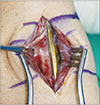Abstract
Ulnar shortening osteotomy is the most popular surgical technique for ulnar impaction syndrome and has a successful clinical results. However, delayed union and nonunion of the osteotomy site remain the most critical complications and conventionally, plate change and autogenous bone grafting had been performed for the treatment of delayed union and nonunion. The authors present 2 patients who had delayed union and nonunion after ulnar shortening osteotomy using 2.7 mm low profile ulnar shortening osteotomy system and can be treated with only additional mini plating.
Figures and Tables
Fig. 2
Simple radiographs of case 1 (white arrows: osteotomy site). (A) Simple radiograph before ulnar shortening osteotomy. (B) Osteotomy was not united till 1 year after ulnar shortening osteotomy. (C) Bridging callus was seen at 1 month after additional mini-plating. (D) Progressive ossification was seen at 2 months after additional mini-plating.

Fig. 3
Simple radiographs of case 2 (white arrows: osteotomy site). (A) Simple radiograph before ulnar shortening osteotomy. (B) Osteotomy was not united till 7 months after ulnar shortening osteotomy. (C) Bridging callus was seen at 1 month after additional mini-plating. (D) Progressive ossification was seen at 2 months after additional mini-plating.

References
2. Köppel M, Hargreaves IC, Herbert TJ. Ulnar shortening osteotomy for ulnar carpal instability and ulnar carpal impaction. J Hand Surg Eur Vol. 1997; 22:451–456.
3. Jungwirth-Weinberger A, Borbas P, Schweizer A, Nagy L. Influence of plate size and design upon healing of ulnashortening osteotomies. J Wrist Surg. 2016; 5:284–289.



4. Martin DE, Zlotolow DA, Russo SA, Kozin SH. Comparison of compression screw and perpendicular clamp in ulnar shortening osteotomy. J Hand Surg Am. 2014; 39:1558–1564.


5. Firoozbakhsh K, Moneim MS, Mikola E, Haltom S. Heat generation during ulnar osteotomy with microsagittal saw blades. Iowa Orthop J. 2003; 23:46–50.


6. Chen F, Osterman AL, Mahony K. Smoking and bony union after ulna-shortening osteotomy. Am J Orthop (Belle Mead NJ). 2001; 30:486–489.

7. Barbaric K, Rujevcan G, Labas M, Delimar D, Bicanic G. Ulnar shortening osteotomy after distal radius fracture malunion: review of literature. Open Orthop J. 2015; 9:98–106.



8. Iwasaki N, Ishikawa J, Kato H, Minami M, Minami A. Factors affecting results of ulnar shortening for ulnar impaction syndrome. Clin Orthop Relat Res. 2007; 465:215–219.






 PDF
PDF ePub
ePub Citation
Citation Print
Print



 XML Download
XML Download